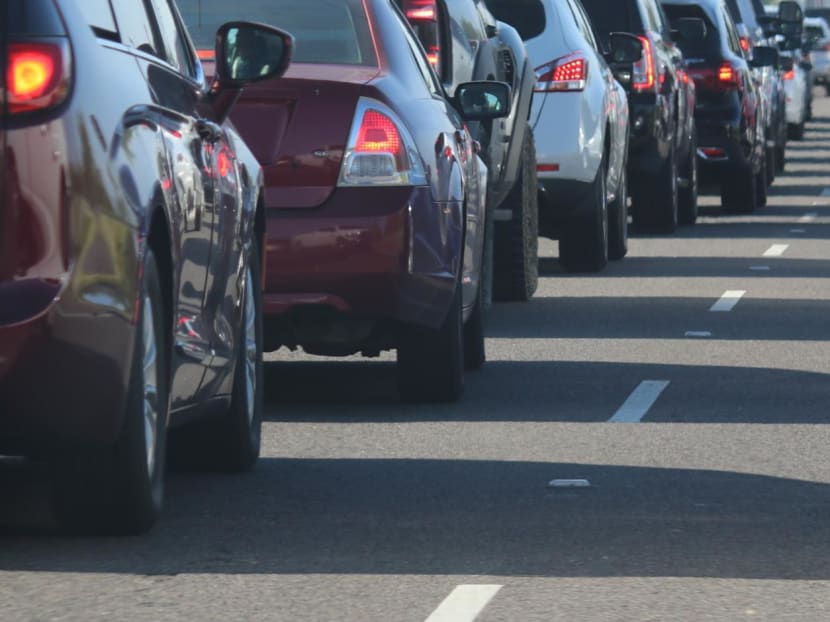Road rage incident: Queue-cutting, lane-changing common causes for flared tempers on Tuas Second Link, motorists say

- A common cause of road rage disputes on the Tuas Second Link stem from motorists who jump queues or switch lanes, drivers said
- Drivers interviewed were divided on how often road rage incidents occur on the linkway between Singapore and Malaysia
- To cut queues, motorists have been known to drive their cars on designated bus or emergency lanes
- They then merge back into the line for cars
SINGAPORE — Road rage incidents on the Tuas Second Link tend to arise from motorists who cut queues or switch lanes when lining up to clear immigration and to cross the border, drivers who often travel into and out of Malaysia said.
However, even though queue-cutting is fairly common, the six drivers who spoke to TODAY on Tuesday (July 12) were divided on how often such disputes happen on the border crossing between Singapore and Johor, Malaysia.
They were commenting after a recent widely publicised video over the weekend showed a woman tearing off the number plate of a car and throwing it at its windscreen in a fit of anger at the Tuas Second Link on the western-end of Singapore.
The Johor police, who are investigating the matter as a case of mischief, said on Sunday that the outburst happened after a Toyota Alphard multi-purpose vehicle switched lanes and collided with a Kia sedan in which the woman was travelling.
A Malaysian in his 30s who gave his name as just “Kelvin”, said: “That was overboard. If you want to scold, just scold a little. But to obstruct traffic while people are already impatient, that’s not good.”
He told TODAY that he runs a private taxi service — commonly referred to by its Chinese name ba wang che — ferrying passengers across the checkpoints.
The incident reminded the driver of a similar outburst he had witnessed in the past on the Second Link, involving a Singapore-registered Toyota Vios sedan and a Hyundai Starex multi-purpose vehicle.
The Hyundai driver had wanted to switch lanes and cut the queue but the sedan driver would not let it get its way.
The Hyundai turned in anyway until the two vehicles touched and moved forward together side-by-side, dragging each other along, he recalled.
The vehicles’ doors were “grinding”, until the Hyundai driver gave up eventually and let the Toyota sedan move on first before merging into the lane.
In that incident, both drivers did not get out of their vehicles and that was the end of the tussle.
Other less dramatic incidents had involved drivers honking or winding down their windows to shout or make rude gestures.
NO TIME TO WAIT
Motorists on the Second Link have been known to jump the queue by driving their cars on designated bus or emergency lanes before merging back into the line for cars.
Photos and videos have surfaced on social media showing cars apparently being caught by customs personnel or police officers from both sides of the linkway and being told to make a U-turn to the back of the line.
Ryan, who manages a Johor-based transport and limousine service, said that one of his drivers has been caught before. The 30-year-old declined to give his full name.
“That’s why I tell my drivers not to cut the queue. Though sometimes, it’s the customers who instruct the drivers to jump the line,” he added.
In those cases, the drivers will inform the passengers that they will have to take full responsibility if they are stopped by the authorities.
Kelvin said that he sometimes finds himself hard-pressed to stay in queue especially when his schedule is tight.
“Let’s say I pick up a passenger at 3pm from Singapore to Legoland (in Johor), which usually takes about 1.5 hours. I will arrange for another pick-up in Johor Bahru at 5pm,” he said.
“If the jam on the Second Link is very bad, I have no choice but to cut the queue. I know it’s not right, especially for those who have been queuing for hours. But I have no choice, I need to make a living.”
Still, road rage incidents and queue-cutting are not isolated to the Second Link.
Kelvin recalls witnessing a quarrel between two Singapore-registered luxury car drivers after a BMW driver, while trying to jump the line, collided into a Mercedes.
The two drivers got out of their vehicles and were arguing on the road, obstructing traffic. A cacophony of car horns honking from other drivers was set in motion and the duo eventually moved to the side of the road to settle their dispute, Kelvin said.
FEW COUNTERS OPEN, WEEKEND PEAKS
Kelvin said that he hears of these instances of road rage on the Second Link happening about two to three times a month, but other drivers had differing accounts of how often they happen.
Mr Yogaraja Subramanian, 38, said that these incidents at the Second Link have become rarer since the Covid-19 pandemic.
“They’re due to frustration, but most importantly, misunderstanding and impatience,” the owner of a Singapore-based minibus company said.
Trips across the Second Link can take more than two hours when there is a traffic jam, compared to about 25 minutes during off-peak periods, he added.
Often when leaving Singapore, motorists would find the Malaysian side opening its immigration counters on just two lanes, leading to vehicles across multiple lanes having to converge onto the two lanes.
“Some of the drivers, they’re very good, they give way and let other cars merge lanes. Some will never give way… and especially on weekends, that’s when many incidents occur,” Mr Yogaraja added.
He said that road rage incidents could be more common on the Second Link than on the Causeway located in Woodlands because motorists entering Johor from the west are often headed towards further destinations such as Malacca or Kuala Lumpur.
Since they have a longer journey ahead of them, motorists tend to be more impatient, he surmised.
USE HAND TO SIGNAL THE OLD-SCHOOL WAY
Digital media executive Mohd Ikhmal Osman, 28, and supply chain manager Maznah Abdul Rahman, 50, both told TODAY in separate phone interviews that they have never witnessed flared tempers on the roads in the past several years that they have crossed the Second Link.
Mr Ikhmal drives into Johor Bahru via the Second Link and the Causeway with his friends about two nights every week for coffee or suppers.
Ms Maznah also used to drive through the Second Link twice a week to visit her relatives, but has not returned since the pandemic. Both of them live in Singapore.
“Frankly, I’ve never experienced this, whether it’s me or my husband driving,” Ms Maznah said, adding that she was shocked when she saw the viral video of the car’s license plate being yanked out that way.
In the past 25 years of travelling across the border, she noted that it can sometimes be dangerous when cars jumping queues at high speeds swerve quickly into the lane to join the line.
Ms Maznah said that she is wary of this, but she deals with this in an old-fashioned, interactive but effective way. “Sometimes when we want to switch lanes, we will put out our hand to signal and gesture to mean, ‘Please give way to us’. Most of the time, people will give way and you won’t have to squeeze into the lane dangerously.”
She has never seen an outburst while crossing the border, but there have been occasions when she has encountered impatient motorists.
“They start to show us their fingers but I just let it go and tell my husband, ‘Aiyah, leave it’,” she said.
“The thing is, we do not retaliate and we do not react. Or else, the next thing you know, you’re all over social media and people start digging into who you are or where you work.”











